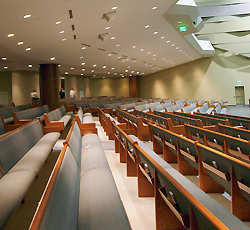
But at the same time for congregational worship, the room requires a more “live” acoustical environment to achieve a “singing in the shower” acoustical feel for the congregation.
How do you make 2,000 people sound like they are singing in the shower while simultaneously controlling the room for reinforced sound?
Again, the answer lies in room shaping and finishes once the room size has been determined. The key is to strike the right balance between reflective surfaces and absorptive surfaces, and then orient them properly. This is where the success or failure of the project will usually be sealed.
Unfortunately there are no easy or standard answers. Since every church is different, every church building should also be different in order to reflect the uniqueness of that particular church. The design team just needs to work through the issues.
Fixing An Existing Room
The classic example of “how to do it wrong” is the fan-shaped room. Such a room is characterized by a concave curved back wall which focuses sound that reflects off it.
Generally, the focusing point is back onto the center of the platform, which can create an acoustical disaster that can cost tens and even hundreds of thousands of dollars to remedy.
Really, the only true fix is to not build it that way in the first place.
If you have a fan-shaped room that is suffering from acoustical problems, the best way to fix it is to treat the focusing surface with sound absorption panels. Treating the walls in this way generally only attenuates, not eliminates, the problem. Often, the panels will have to be angled so as to change the direction of the reflection into an area where it will not create a problem.
The rub is that once one aspect of the room acoustics is changed to fix one problem, it may create other problems. For example, adding absorption in the room to mitigate the focusing problem may also inadvertently absorb all the sound energy necessary to create a live environment for congregational worship, or it may eliminate some early sound reflections that are beneficial.
So solving the problem may not be as simple as originally thought. Fortunately, computer-aided modeling and design tools are available to help determine the problem, analyze options for solving it, and foresee all the effects of proposed solutions.
Movin’ On Down the Road
Once you have a qualified acoustical consultant on your project, listen to that person and follow the recommendations. Whether you’re building a new facility, renovating an existing facility, or fixing an existing problem, the challenges can be formidable.
The key is to engage a good acoustical consultant early in the project. By doing so, you will vastly improve your project’s chances for success.
And oh, by the way, try to stay away from those fan-shaped rooms. It will help me sleep better.
Vance Breshears has worked for decades as a system designer and consultant in the professional AV industry, and heads up the California offices of Acoustic Dimensions.
